PAHs Source Identification in Sediments and Surrounding Soils of Poyang Lake in China Using Non-Negative Matrix Factorization Analysis
Abstract
:1. Introduction
2. Materials and Methods
2.1. Research Area and Sampling
2.2. Experimental Analysis
2.3. Non-Negative Matrix Factorization (NMF)
2.4. Data Analysis
3. Results and Discussion
3.1. Soil Residual PAHs
3.2. Sediment Residual PAHs
3.3. Soil Residual PAHs for Different Land Use Types
3.4. Ratio Analysis of PAHs Sources in Poyang Lake District
3.5. NMF Analysis for PAHs Sources in Poyang Lake
4. Conclusions
Author Contributions
Funding
Institutional Review Board Statement
Data Availability Statement
Conflicts of Interest
References
- Wang, Z.; Wang, Y.; Ma, X.D.; Na, G.S.; Lin, Z.S.; Yao, Z.W. Probabilistic Ecological Risk Assessment of Typical PAHs in Coastal Water of Bohai Sea. Polycycl. Aromat. Compd. 2013, 33, 367–379. [Google Scholar] [CrossRef]
- Li, J.F.; Dong, H.; Xu, X.; Han, B.; Li, X.G.; Zhu, C.J.; Han, C.; Liu, S.P.; Yang, D.D.; Xu, Q.; et al. Prediction of the bioaccumulation of PAHs in surface sediments of Bohai Sea, China and quantitative assessment of the related toxicity and health risk to humans. Mar. Pollut. Bull. 2016, 104, 92–100. [Google Scholar] [CrossRef] [PubMed]
- Ma, W.L.; Zhu, F.J.; Liu, L.Y.; Jia, H.L.; Yang, M.; Li, Y.F. PAHs in Chinese atmosphere Part II: Health risk assessment. Ecotoxicol. Environ. Saf. 2020, 200, 110774. [Google Scholar] [CrossRef] [PubMed]
- Ali, N. Polycyclic aromatic hydrocarbons (PAHs) in indoor air and dust samples of different Saudi microenvironments; health and carcinogenic risk assessment for the general population. Sci. Total Environ. 2019, 696, 133995. [Google Scholar] [CrossRef]
- Zeng, S.Y.; Ma, J.; Ren, Y.H.; Liu, G.J.; Zhang, Q.; Chen, F. Assessing the Spatial Distribution of Soil PAHs and their Relationship with Anthropogenic Activities at a National Scale. Int. J. Environ. Res. Public Health 2019, 16, 4928. [Google Scholar] [CrossRef] [Green Version]
- Bartolome, N.; Hilber, I.; Schulin, R.; Mayer, P.; Witt, G.; Reininghaus, M.; Bucheli, T.D. Comparison of freely dissolved concentrations of PAHs in contaminated pot soils under saturated and unsaturated water conditions. Sci. Total Environ. 2018, 644, 835–843. [Google Scholar] [CrossRef]
- Hadibarata, T.; Syafiuddin, A.; Ghfar, A.A. Abundance and distribution of polycyclic aromatic hydrocarbons (PAHs) in sediments of the Mahakam River. Mar. Pollut. Bull. 2019, 149, 110650. [Google Scholar] [CrossRef]
- He, Y.; Yang, C.; He, W.; Xu, F.L. Nationwide health risk assessment of juvenile exposure to polycyclic aromatic hydrocarbons (PAHs) in the water body of Chinese lakes. Sci. Total Environ. 2020, 723, 138099. [Google Scholar] [CrossRef]
- Merhaby, D.; Rabodonirina, S.; Net, S.; Ouddane, B.; Halwani, J. Overview of sediments pollution by PAHs and PCBs in mediterranean basin: Transport, fate, occurrence, and distribution. Mar. Pollut. Bull. 2019, 149, 110646. [Google Scholar] [CrossRef]
- Han, B.; Zheng, L.; Lin, F.X. Risk assessment and source apportionment of PAHs in surface sediments from Caofeidian Long Island, China. Mar. Pollut. Bull. 2019, 145, 42–46. [Google Scholar] [CrossRef]
- Qu, Y.J.; Gong, Y.W.; Ma, J.; Wei, H.Y.; Liu, Q.Y.; Liu, L.L.; Wu, H.W.; Yang, S.H.; Chen, Y.X. Potential sources, influencing factors, and health risks of polycyclic aromatic hydrocarbons (PAHs) in the surface soil of urban parks in Beijing, China. Environ. Pollut. 2020, 260, 114016. [Google Scholar] [CrossRef] [PubMed]
- Ahmad, M.; Yang, Q.S.; Zhang, Y.Y.; Ling, J.; Sajjad, W.; Qi, S.H.; Zhou, W.G.; Zhang, Y.; Lin, X.C.; Zhang, Y.H.; et al. The distinct response of phenanthrene enriched bacterial consortia to different PAHs and their degradation potential: A mangrove sediment microcosm study. J. Hazard. Mater. 2019, 380, 120863. [Google Scholar] [CrossRef] [PubMed]
- Zhan, C.L.; Wan, D.J.; Han, Y.M.; Zhang, J.Q. Historical variation of black carbon and PAHs over the last similar to 200 years in central North China: Evidence from lake sediment records. Sci. Total Environ. 2019, 690, 891–899. [Google Scholar] [CrossRef] [PubMed]
- Qian, Z.; Mao, Y.; Xiong, S.; Peng, B.; Liu, W.; Liu, H.F.; Zhang, Y.; Chen, W.; Zhou, H.; Qi, S.H. Historical residues of organochlorine pesticides (OCPs) and polycyclic aromatic hydrocarbons (PAHs) in a flood sediment profile from the Longwang Cave in Yichang, China. Ecotoxicol. Environ. Safe 2020, 196, 110542. [Google Scholar] [CrossRef]
- Zhao, X.G.; Jin, H.Y.; Ji, Z.Q.; Li, D.H.; Kaw, H.Y.; Chen, J.F.; Xie, Z.Y.; Zhang, T. PAES and PAHs in the surface sediments of the East China Sea: Occurrence, distribution and influence factors. Sci. Total Environ. 2020, 703, 134763. [Google Scholar] [CrossRef]
- Lei, P.; Pan, K.; Zhang, H.; Bi, J.L. Pollution and Risk of PAHs in Surface Sediments from the Tributaries and Their Relation to Anthropogenic Activities, in the Main Urban Districts of Chongqing City, Southwest China. Bull. Environ. Contam. Toxicol. 2019, 103, 28–33. [Google Scholar] [CrossRef]
- Liu, W.Y.; Wang, D.; Singh, V.P.; Wang, Y.K.; Zeng, X.K.; Ni, L.L.; Tao, Y.W.; Wu, J.C.; Liu, J.F.; Zou, Y.; et al. A hybrid statistical model for ecological risk integral assessment of PAHs in sediments. J. Hydrol. 2020, 583, 124612. [Google Scholar] [CrossRef]
- Liu, F.; Yang, Q.S.; Hu, Y.J.; Du, H.H.; Yuan, F. Distribution and transportation of polycyclic aromatic hydrocarbons (PAHs) at the Humen river mouth in the Pearl River delta and their influencing factors. Mar. Pollut. Bull. 2014, 84, 401–410. [Google Scholar] [CrossRef]
- Yu, Y.J.; Yu, Z.L.; Wang, Z.D.; Lin, B.G.; Li, L.Z.; Chen, X.C.; Zhu, X.H.; Xiang, M.D.; Ma, R.X. Polycyclic aromatic hydrocarbons (PAHs) in multi-phases from the drinking water source area of the Pearl River Delta (PRD) in South China: Distribution, source apportionment, and risk assessment. Environ. Sci. Pollut. Res. 2018, 25, 12557–12569. [Google Scholar] [CrossRef]
- Ding, Y.K.; Wang, S.R.; Zhang, W.Q.; Feng, M.L.; Yu, R.H. A rule of hydrological regulating on nutritional status of Poyang Lake, since the operation of the Three Gorges Dam. Ecol. Indic. 2019, 104, 535–542. [Google Scholar] [CrossRef]
- Li, B.; Yang, G.S.; Wan, R.R. Multidecadal water quality deterioration in the largest freshwater lake in China (Poyang Lake): Implications on eutrophication management. Environ. Pollut. 2020, 260, 114033. [Google Scholar] [CrossRef] [PubMed]
- Cai, H.; Mei, Y.D.; Chen, Y.Y. An Analysis of a Water Use Decoupling Index and Its Spatial Migration Characteristics Based on Extracting Trend Components: A Case Study of the Poyang Lake Basin. Water 2019, 11, 1027. [Google Scholar] [CrossRef] [Green Version]
- Tian, Q.; Holland, J.H.; Brown, D.G. Social and economic impacts of subsidy policies on rural development in the Poyang Lake Region, China: Insights from an agent-based model. Agric. Syst. 2016, 148, 12–27. [Google Scholar] [CrossRef]
- Sun, C.Z.; Zhen, L.; Miah, M.G. Comparison of the ecosystem services provided by China’s Poyang Lake wetland and Bangladesh’s Tanguar Haor wetland. Ecosyst. Serv. 2017, 26, 411–421. [Google Scholar] [CrossRef]
- Liao, M.N.; Yu, G.; Guo, Y. Eutrophication in Poyang Lake (Eastern China) over the Last 300 Years in Response to Changes in Climate and Lake Biomass. PLoS ONE 2017, 12, e0169319. [Google Scholar] [CrossRef] [PubMed]
- Li, Q.Y.; Wu, J.L.; Zhao, Z.H. Spatial and temporal distribution of Polycyclic Aromatic Hydrocarbons (PAHs) in sediments from Poyang Lake, China. PLoS ONE 2018, 13, e0205484. [Google Scholar] [CrossRef] [PubMed]
- Xie, H.L.; Wang, P.; Huang, H.S. Ecological Risk Assessment of Land Use Change in the Poyang Lake Eco-economic Zone, China. Int. J. Environ. Res. Public Health 2013, 10, 328–346. [Google Scholar] [CrossRef] [Green Version]
- De Almeida, M.; do Nascimento, D.V.; Mafalda, P.D.; Patire, V.F.; de Albergaria-Barbosa, A.C.R. Distribution and sources of polycyclic aromatic hydrocarbons (PAHs) in surface sediments of a Tropical Bay influenced by anthropogenic activities (Todos os Santos Bay, BA, Brazil). Mar. Pollut. Bull. 2018, 137, 399–407. [Google Scholar] [CrossRef]
- Wang, C.Y.; Zou, Y.M.; Yu, L.J.; Lv, Y.C. Potential source contributions and risk assessment of PAHs in sediments from the tail-reaches of the Yellow River Estuary, China: PCA model, PMF model, and mean ERM quotient analysis. Environ. Sci. Pollut. Res. 2020, 27, 9780–9789. [Google Scholar] [CrossRef]
- Jia, J.P.; Bi, C.J.; Zhang, J.F.; Jin, X.P.; Chen, Z.L. Characterization of polycyclic aromatic hydrocarbons (PAHs) in vegetables near industrial areas of Shanghai, China: Sources, exposure, and cancer risk. Environ. Pollut. 2018, 241, 750–758. [Google Scholar] [CrossRef]
- Keshavarzi, B.; Abbasi, S.; Moore, F.; Mehravar, S.; Sorooshian, A.; Soltani, N.; Najmeddin, A. Contamination Level, Source Identification and Risk Assessment of Potentially Toxic Elements (PTEs) and Polycyclic Aromatic Hydrocarbons (PAHs) in Street Dust of an Important Commercial Center in Iran. Environ. Manag. 2018, 62, 803–818. [Google Scholar] [CrossRef] [PubMed]
- Gaujoux, R. An Introduction to NMF Package. 2018. Available online: https://r-forge.r-project.org/R/?group_id=649 (accessed on 7 March 2022).
- Tian, F.; Chen, J.; Qiao, X.; Cai, X.; Yang, P.; Wang, Z.; Wang, D. Source identification of PCDD/Fs and PCBs in pine (Cedrus deodara) needles: A case study in Dalian, China. Atmos. Environ. 2008, 42, 4769–4777. [Google Scholar] [CrossRef]
- De Vries, W.; Bakker, D.J. Manual for Calculating Critical Loads of Heavy Metals for Terrestrial Ecosystem: Guidelines for Critical Limits, Calculation Methods and Input Data; TNO Institute of Environmental Sciences, Energy Research and Process Innovation: Den Helder, The Netherlands, 1998; p. 144. [Google Scholar]
- CCME (Canadian Council of Ministers of the Environment). A Protocol for the Derivation of Environmental and Human Health Soil Quality Guidelines; CCME-EPC-101E; CCME: Ottawa, Canada, 1996; p. 169. [Google Scholar]
- Ma, R.; Yang, G.; Duan, H. China’s lakes at present: Number, area and spatial distribution. Sci. China Earth Sci. 2011, 54, 283–289. [Google Scholar] [CrossRef]
- Li, C.C.; Huo, S.L.; Yu, Z.Q. National investigation of semi-volatile organic compounds (PAHs, OCPs, and PCBs) in lake sediments of China: Occurrence, spatial variation and risk assessment. Sci. Total Environ. 2017, 579, 325–336. [Google Scholar] [CrossRef] [PubMed]
- Meng, Y. A review on occurrence and risk of polycyclic aromatic hydrocarbons (PAHs) in lakes of China. Sci. Total Environ. 2019, 651, 2497–2506. [Google Scholar] [CrossRef]
- Zhao, Z.H.; Jiang, Y.; Li, Q.Y.; Cai, Y.J.; Yin, H.B.; Zhang, L.; Zhang, J. Spatial correlation analysis of polycyclic aromatic hydrocarbons (PAHs) and organochlorine pesticides (OCPs) in sediments between Taihu Lake and its tributary rivers. Ecotoxicol. Environ. Safe 2017, 142, 117–128. [Google Scholar] [CrossRef] [Green Version]
- He, J.; Yang, Y.J.; Zhang, L.G.; Luo, Y.S.; Liu, F.; Yang, P.H. Polycyclic Aromatic Hydrocarbons (PAHs) in Surface Sediments of two Lakes of the Dongting Lake District in Hunan, China. In Proceedings of the International Conference on Biotechnology and Bioengineering, Budapest, Hungary, 24–26 October 2018; Trincone, A., Azevedo, J.L., Gong, M., Eds.; AIP Publishing LLC: Melville, NY, USA, 2018. [Google Scholar]
- Lin, F.; Han, B.; Ding, Y.; Li, Q.; Gao, W.; Zheng, L. Distribution characteristics, sources, and ecological risk assessment of polycyclic aromatic hydrocarbons in sediments from the Qinhuangdao coastal wetland, China. Mar. Pollut. Bull. 2018, 127, 788–793. [Google Scholar] [CrossRef]
- Han, L.; Bai, J.; Gao, Z.; Wang, W.; Wang, D.; Cui, B.; Liu, X. Polycyclic aromatic hydrocarbons (PAHs) in surface soils from reclaimed and ditch wetlands along a 100-year chronosequence of reclamation in a Chinese estuary: Occurrence, sources, and risk assessment. Agric. Ecosyst. Environ. 2019, 286, 106648. [Google Scholar] [CrossRef]
- Motelay-Massei, A.; Ollivon, D.; Garban, B.; Teil, M.J.; Blanchard, M.; Chevreuil, M. Distribution and spatial trends of PAHs and PCBs in soils in the Seine River basin, France. Chemosphere 2004, 55, 555–565. [Google Scholar] [CrossRef]
- Friesen, M.C.; Demers, P.A.; Spinelli, J.J.; Le, N.D. Adequacy of Benzo(A)Pyrene and Benzene Soluble Materials as Indicators of Exposure to Polycyclic Aromatic Hydrocarbons in a Sderberg Aluminum Smelter. J. Occup. Environ. Hyg. 2008, 5, 6–14. [Google Scholar] [CrossRef]
- Li, A.; Jang, J.K.; Scheff, P.A. Application of EPA CMB8.2 model for source apportionment of sediment PAHs in Lake Calumet, Chicago. Environ. Sci. Technol. 2003, 37, 2958–2965. [Google Scholar] [CrossRef] [PubMed]
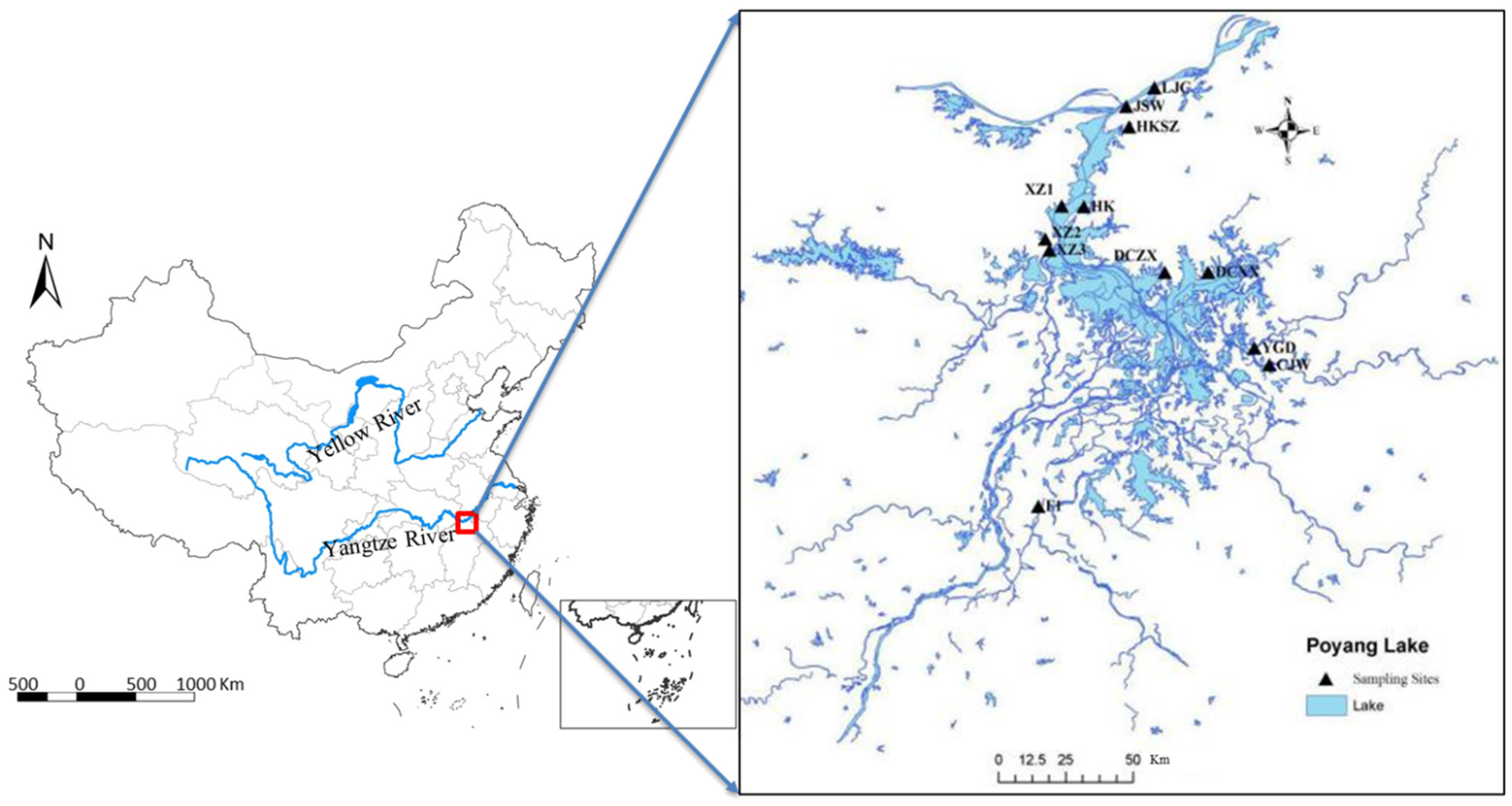

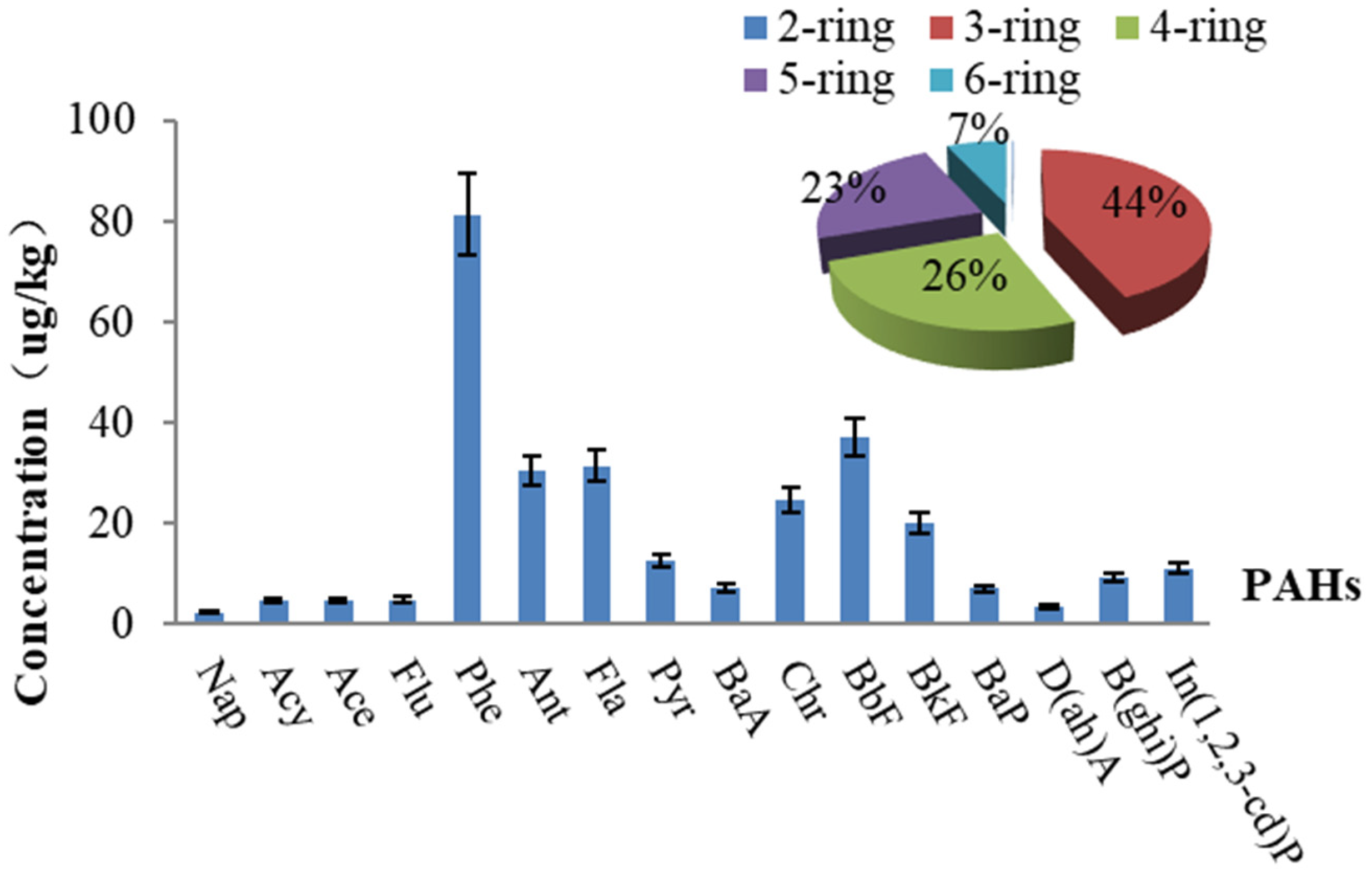
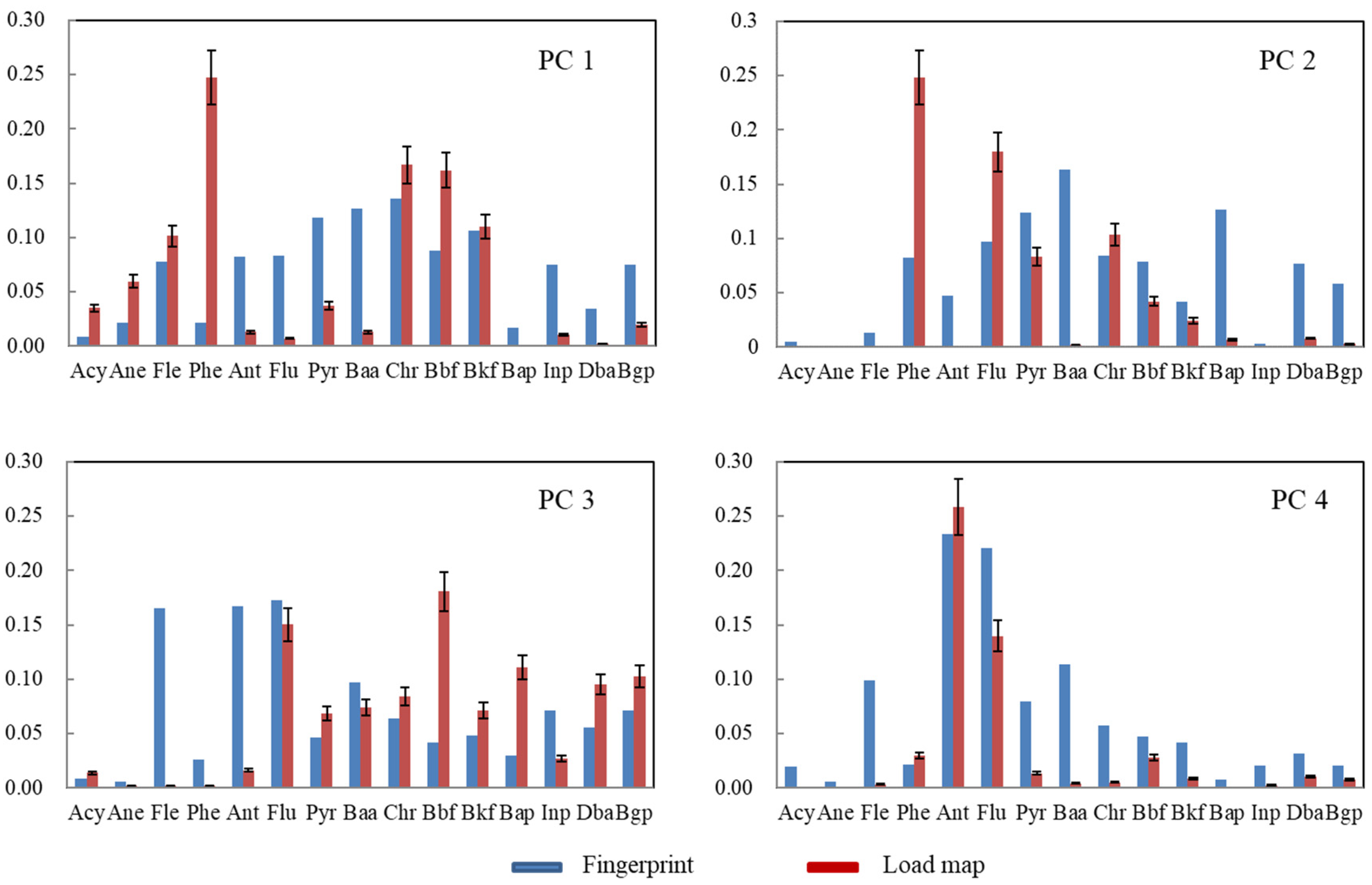
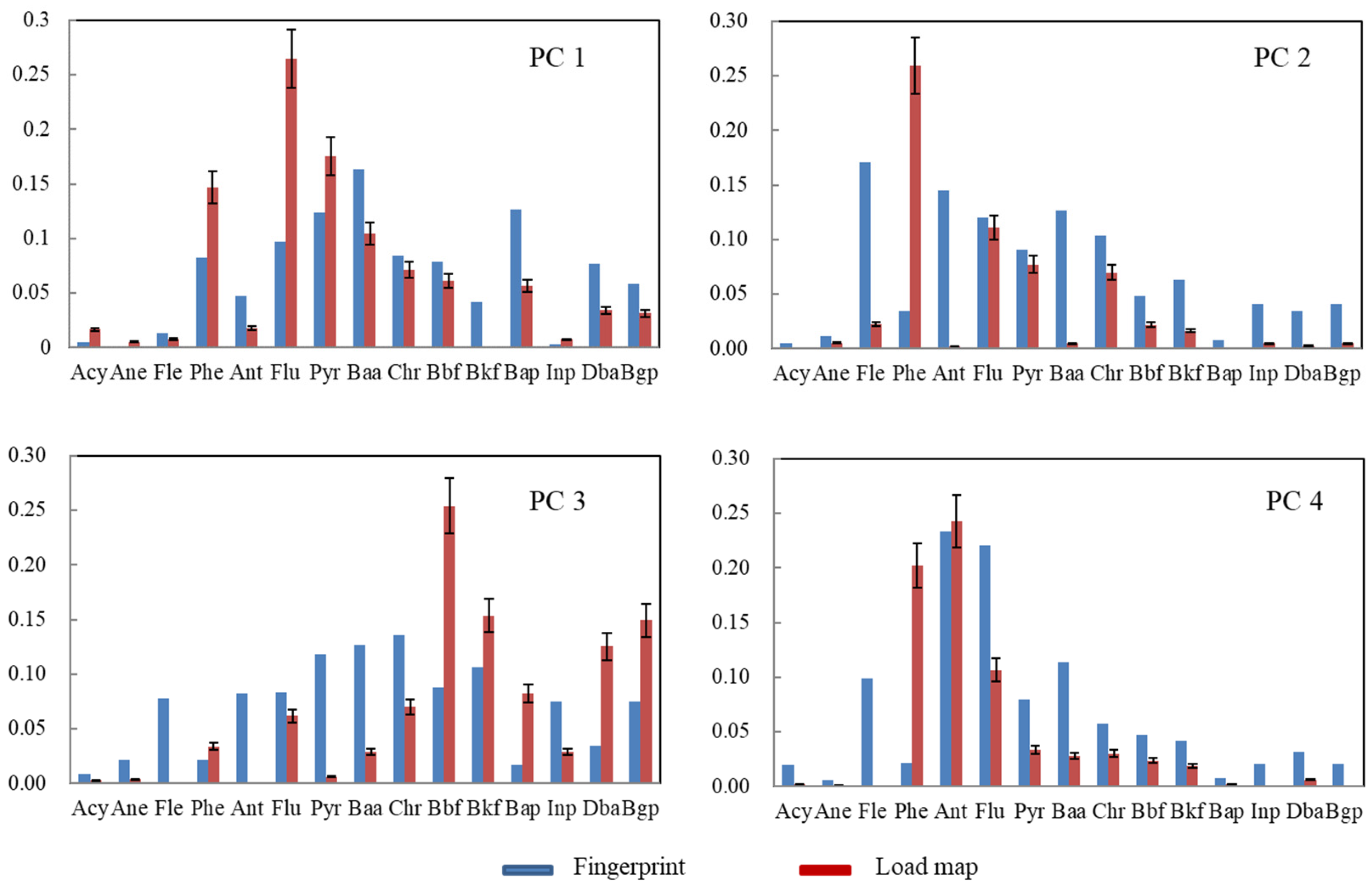
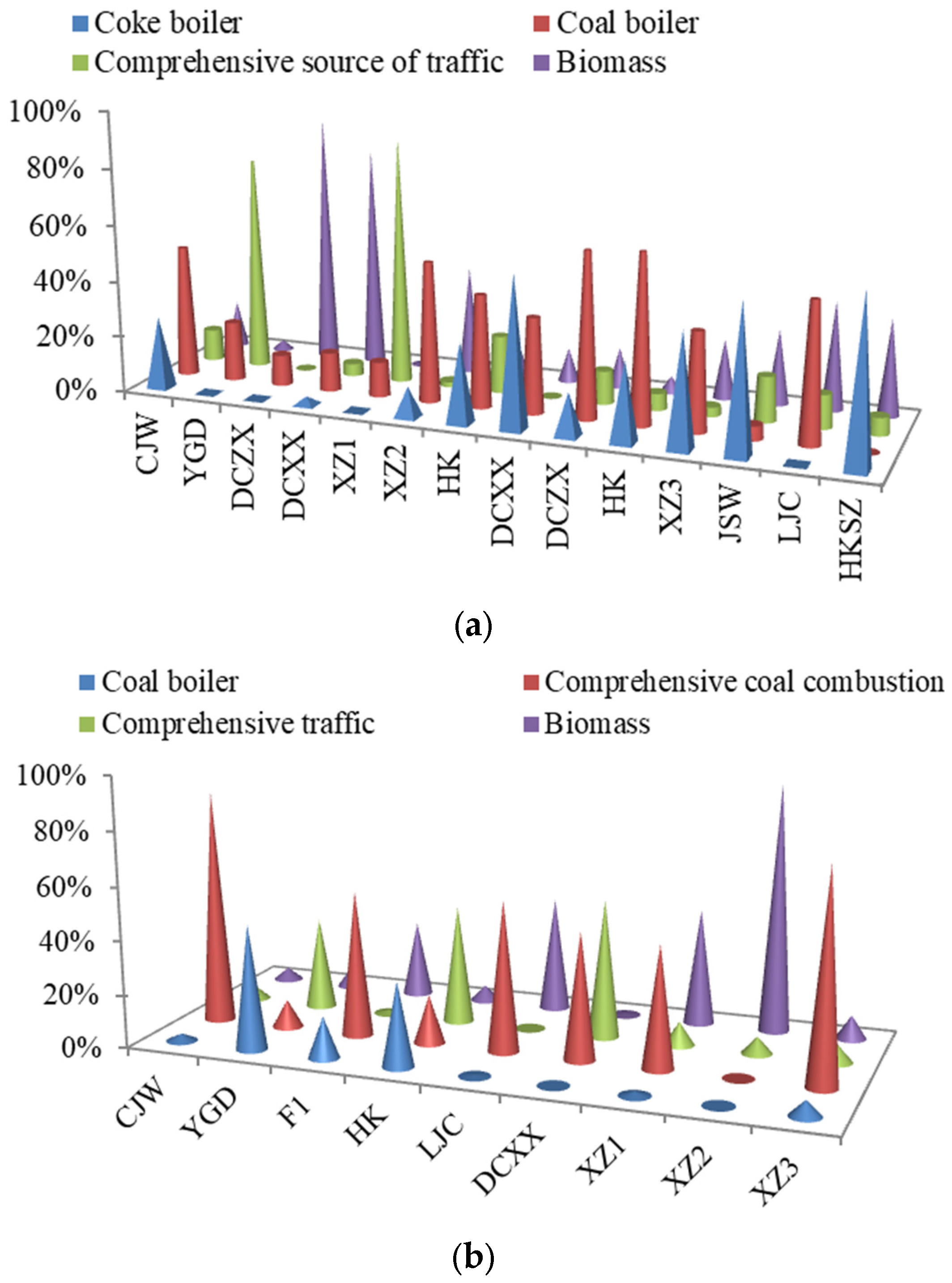
| PAH | Soil (mg·g−1) | Sediment (μg·kg−1) [10] | ||||||
|---|---|---|---|---|---|---|---|---|
| The Netherlands [34] | Canada [35] | ERL | ERM | |||||
| NA | NB | NC | CA | CB | CC | |||
| Nap | 0.015 | 5 | 50 | 0.1 | 5 | 50 | 160 | 2100 |
| Acy | – | – | – | – | – | – | 44 | 640 |
| Ace | – | – | – | – | – | – | 16 | 500 |
| Flu | – | – | – | – | – | – | 19 | 540 |
| Phe | 0.05 | 10 | 100 | 0.1 | 5 | 50 | 240 | 1500 |
| Ant | 0.05 | 10 | 100 | – | – | – | 853 | 1100 |
| Fla | 0.015 | 10 | 100 | – | – | – | 600 | 5100 |
| Pyr | – | – | – | 0.1 | 10 | 100 | 665 | 2600 |
| BaA | 0.02 | 5 | 50 | 0.1 | 1 | 10 | 261 | 1600 |
| Chr | 0.02 | 5 | 50 | – | – | – | 384 | 2800 |
| BbF | – | – | – | – | – | – | – | – |
| BkF | 0.025 | 5 | 50 | – | – | – | – | – |
| BaP | 0.025 | 1 | 10 | 0.1 | 1 | 10 | 430 | 1600 |
| D(ah)a | – | – | – | 0.1 | 1 | 10 | 63.4 | 260 |
| B(ghi)P | 0.02 | 10 | 100 | – | – | – | – | – |
| Inp | 0.025 | 5 | 50 | – | – | – | – | – |
| PAHs | – | – | – | – | – | – | 4000 | 44,792 |
| Location | PAH Concentration | Reference | |
|---|---|---|---|
| 1 | Caofeidian | 52–806 (16) | [10] |
| 2 | Yangtze River, Chongqing | 221–3205 (16) | [16] |
| 3 | Bohai | 149.4–1212.0 (16) | [2] |
| 4 | Langwang Cave, Yichang | 5.05–82.6 (16) | [14] |
| 5 | Yellow River estuary | 10.8–252 (16) | [29] |
| 6 | Gonghai Lake, Shanxi | 17.43–459.6 (12) | [13] |
| 7 | East China Sea | 57.5–364.5 (16) | [15] |
| 8 | Taihu Lake Basin | 12.1–2281.1 (16) | [39] |
| 9 | Dongting Lake | 206.6–1059.0 (16) | [40] |
| 10 | Northeast Lakes District | 89.1–7935.21 (16) | [38] |
| 11 | Eastern Lakes District | 19.5–6993 (16) | [38] |
| 12 | Yunnan–Guizhou Lakes District | 21.8–6418 (16) | [38] |
| 13 | This study | 142.1–3205.4 (16) |
| Location | PAH Concentration | Reference | |
|---|---|---|---|
| 1 | Caofeidian | 52–806 (16) | [10] |
| 2 | Yangtze River, Chongqing | 221–3205 (16) | [16] |
| 3 | Bohai | 149.4–1212.0 (16) | [2] |
| 4 | Langwang Cave, Yichang | 5.05–82.6 (16) | [14] |
| 5 | Yellow River estuary | 10.8–252 (16) | [29] |
| 6 | Gonghai Lake, Shanxi | 17.43–459.6 (12) | [13] |
| 7 | East China Sea | 57.5–364.5 (16) | [15] |
| 8 | Taihu Lake Basin | 12.1–2281.1 (16) | [39] |
| 9 | Dongting Lake | 206.6–1059.0 (16) | [40] |
| 10 | Pearl River Estuary | 67–1172.8 (16) | [42] |
| 11 | Qinhuangdao | 341.61–4703.80 (16) | [41] |
| 12 | This study | 142.1–3205.4 (16) |
| Ratio | Level | Hu Kou | Du Chang | Xing Zi | Bo Yang | Estuary |
|---|---|---|---|---|---|---|
| Phe/Ant | Minimum | 1.02 | 2.02 | 0.37 | 4.84 | – |
| Maximum | 5.99 | 110.45 | 18.41 | 34.98 | – | |
| Mean | 3.33 | 24.15 | 6.69 | 13.61 | 4.78 | |
| Flu/Pyr | Minimum | 0.005 | 0 | 0 | 0 | – |
| Maximum | 0.65 | 1.37 | 0.76 | 0.23 | – | |
| Mean | 0.41 | 0.29 | 0.23 | 0.08 | 0.04 | |
| Pyr/BaP | Minimum | 1.52 | 0.78 | 0.61 | 1.68 | – |
| Maximum | 29.33 | 8.79 | 19.63 | 12.23 | – | |
| Mean | 9.54 | 4.19 | 6.69 | 5.49 | 14.63 |
Publisher’s Note: MDPI stays neutral with regard to jurisdictional claims in published maps and institutional affiliations. |
© 2022 by the authors. Licensee MDPI, Basel, Switzerland. This article is an open access article distributed under the terms and conditions of the Creative Commons Attribution (CC BY) license (https://creativecommons.org/licenses/by/4.0/).
Share and Cite
Chen, C.; Zeng, H.; Gong, X.; Li, J.; Wang, L. PAHs Source Identification in Sediments and Surrounding Soils of Poyang Lake in China Using Non-Negative Matrix Factorization Analysis. Land 2022, 11, 843. https://doi.org/10.3390/land11060843
Chen C, Zeng H, Gong X, Li J, Wang L. PAHs Source Identification in Sediments and Surrounding Soils of Poyang Lake in China Using Non-Negative Matrix Factorization Analysis. Land. 2022; 11(6):843. https://doi.org/10.3390/land11060843
Chicago/Turabian StyleChen, Chunli, Huiqing Zeng, Xiaofeng Gong, Jing Li, and Lingqing Wang. 2022. "PAHs Source Identification in Sediments and Surrounding Soils of Poyang Lake in China Using Non-Negative Matrix Factorization Analysis" Land 11, no. 6: 843. https://doi.org/10.3390/land11060843
APA StyleChen, C., Zeng, H., Gong, X., Li, J., & Wang, L. (2022). PAHs Source Identification in Sediments and Surrounding Soils of Poyang Lake in China Using Non-Negative Matrix Factorization Analysis. Land, 11(6), 843. https://doi.org/10.3390/land11060843







